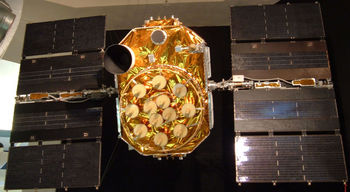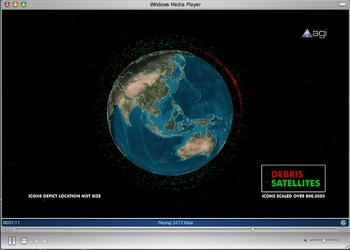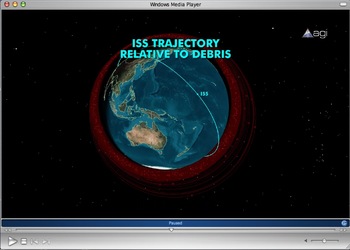Space Arms Race, Here we Come!
Posted on Wednesday, January 31, 2007

Click to enlarge
Click to enlarge
Click to enlarge
[Update Friday 2nd Feb 02:00 CET: The new space race has apparently already started. More news, including a STK visualisation of the debris cloud resulting from the kinetic kill, at AGI's Center for Space Standards & Innovation (CSSI) (via Spaceports blog)]
Excellent title of this space blog entry at the Lifeboat Foundation, following the Chinese Anti Satellite (ASAT) weapons test earlier this month:
Space Arms Race, Here we Come!It’s true - when one nation moves into space weapons, others are forced to follow just to keep up. It’s the Red Queen scenario, where you have to keep moving forward just to stay in the same place. Because preventing the weaponization of space is likely impossible, it looks like we will have to come to terms with it. One beneficial side effect of a space weapons could be the development of better space systems in general, which could eventually be used to create autonomous colonies.
The latter could actually be true. If so, what could be the emerging technologies out of this new weapons race, or out of the upcoming peaceful Moon race variant as described in this 2004 Space.com article:
Strategic target“The moon is the first step beyond low Earth orbit that any spacefaring nation is going to try to master,” said Mike Duke, a geologist at the Colorado School of Mines in Golden, Colo. The Europeans have passed that mark, he added, so their lunar missions are described as technology demonstrations.
Meanwhile, the Japanese are trying to display their technical prowess in instrumentation. “They need to demonstrate a reasonable launch capability to be considered a player in that arena. They’ve had some problems, so maybe the lunar mission is a driver to keep the rocket folks focused,” Duke said.
Duke said China and India have arrived at a place in their development where they can do lunar missions and gain in stature among spacefaring nations.
“I’m afraid that I don’t see that any of these really involve the moon as a strategic target for exploration, though everyone is looking for that strategic handle,” Duke said.
“I'm not sure what to make of it all in the grand scheme of things,” said Paul Spudis, a planetary scientist at the The Johns Hopkins University Applied Physics Laboratory (APL) in Laurel, Maryland.
A number of factors are stirring multi-nation lunar interests, Spudis said. For starters, in the quest to get beyond low Earth orbit, the moon is an easy first target. Then there’s the idea that, somehow, the moon’s history is intimately tied to that of the Earth. Lastly, there is the simultaneous emergence of space capabilities among industrialized countries, as well as coincidence.
“Which predominates? I’m not sure,” Spudis said. “I’d like to think that there is emerging recognition of the strategic value of the moon. But although I do think that is present, it’s not the principal driver,” said Spudis, who was a member of the President’s Commission on Implementation of United States Space Exploration Policy, which advised the White House on how best to move forward on a moon, Mars, and beyond human and robotic exploration strategy.
“In fact, as far as the [Bush] Administration goes, it is the principal driver of the vision, not a human Mars mission … in contradistinction [contradiction] to the intense belief of many who work at NASA,” he said.
Pointing to several nations that are hammering out lunar exploration plans, Spudis said he senses that India’s program is an attempt to promote space science and technology, and demonstrate that they are, indeed, a 21st century, industrial nation. China has similar goals, he said, but is focused more on servicing their “international inferiority complex” to help underscore “that they too are a great nation.”
The emerging technologies from some earlier military involvement in space included what...V2? Sputnik? microprocessors (as discussed in an earlier post)? Keyhole (aka Keyhole)? GPS? Its probably a bit too early to discuss now, but I can see it become part of this conference in the future.
Btw, I am curious to see the trajectory of the Chinese interceptor in Google Earth, anyone has a line to the Chinese military?...the American military perhaps? If so, drop me a note or leave a comment!
1 Comments:
Ha,
Je was me voor, ik wilde hier ook een stukje aan wijden,
maar had er nog geen tijd voor gevonden. Later misschien...
maar wel interessant een nieuwe wapenwedloop.
Op zich is er een historische parallel, na WO1 bleven er heel veel vliegtuigen over die later werden ingezet voor transport van post en personen. WO2 leidde natuurlijk tot de straalmotor en raketten etcetera etcetera
February 1, 2007 8:14 AM